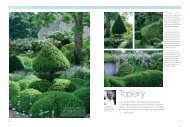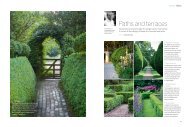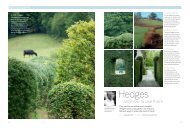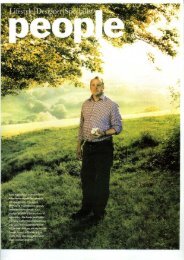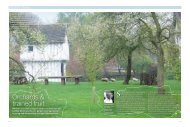Cottage garden style - Arne Maynard Garden Design
Cottage garden style - Arne Maynard Garden Design
Cottage garden style - Arne Maynard Garden Design
You also want an ePaper? Increase the reach of your titles
YUMPU automatically turns print PDFs into web optimized ePapers that Google loves.
DESIGN IDEAS<br />
6. Reclaimed<br />
materials<br />
The cottage <strong>garden</strong> should<br />
be dominated by plants, with<br />
only a small amount of hard<br />
landscaping. Here, abundant<br />
planting spills on to a narrow<br />
path of loosely laid, reclaimed<br />
brick in which the joints have<br />
been left un-mortared to<br />
allow mosses to gather and<br />
plants to self-seed in true<br />
cottage-<strong>garden</strong> <strong>style</strong>.<br />
7. Beautiful balance<br />
A whole scramble of things<br />
grow in front of a lovely old<br />
timbered house that looks as<br />
though it has been this way<br />
forever. House and plants<br />
co-exist in harmony. Tidiness<br />
is not the point and the effect<br />
is achieved partly by choosing<br />
the right kind of roses for the<br />
purpose – this one is a<br />
vigorous climber.<br />
8. Working areas<br />
Produce is an essential part of<br />
the cottage <strong>garden</strong> ethos, and<br />
I’d put a plot for vegetables<br />
where it can be seen. Here<br />
practicality and ornament<br />
combine in a working area of<br />
the <strong>garden</strong>, with runner beans<br />
on metal arches framing a<br />
simple chipping path.<br />
My memories of growing up in a small<br />
village in Dorset in the late 1960s and<br />
1970s will always influence my idea<br />
of cottage <strong>garden</strong>s. For me, the cottage <strong>garden</strong> has<br />
a strong element of functionality. It doesn’t have<br />
structures or grand terraces, and space is often<br />
limited. The art of cottage <strong>garden</strong>ing was to get as<br />
much out of the area as possible, and to nourish<br />
the family. The people who made them were<br />
<strong>garden</strong>ers, and proud of their skills. There’d be<br />
amazing flowers, many grown for practical and<br />
medicinal as well as ornamental purposes. With<br />
the busy lives we lead today, I think this functionality<br />
is a beautiful principle to come back to, and<br />
6 7<br />
8 9<br />
it’s the heartbeat of a cottage <strong>garden</strong>: a place to<br />
grow vegetables and flowers all mixed in together.<br />
The <strong>garden</strong>s I remember – and the ones that<br />
still inspire me – used vernacular materials. They<br />
might have had a flint-and-brick wall in front, or<br />
a native hedge that was a bit bumpy and clipped<br />
growing on a raised bank. There might be a<br />
briar rose growing into the hedge, or apple<br />
trees growing out if it – a space-saving device<br />
so the tree would overhang the boundary on<br />
to the lane. On the verge there would be long<br />
grass with ox-eye daisies.<br />
These are the elements I draw on when I’m<br />
making a cottage <strong>garden</strong>, and I’ll often put an<br />
6 MARIANNE MAJERUS; 7 FAIZAN BALABIL / GARDEN WORLD IMAGES; 8 MARIANNE MAJERUS; 9 MAP/NATHALIE PASQUEL / GARDEN WORLD IMAGES<br />
apple tree to one side of the gate, so that you’re<br />
stooping down under the boughs to go in. It’s<br />
about reducing scale, because in a true cottage<br />
<strong>garden</strong> everything is crammed in.<br />
To one side of the path there might be a<br />
vegetable <strong>garden</strong>. Mixed in with the vegetables and<br />
fruit would be a few rows of sweet peas and, later,<br />
chrysanthemums, because these could be cut and<br />
sold to supplement the family’s income.<br />
Again, this element of functionality is important,<br />
and the danger now with making a cottage<br />
<strong>garden</strong> is that it can become themed, and lose the<br />
connection with its roots. It’s not a place for grand<br />
borders, intricate gates or smart furniture.<br />
Often, the work I do as a designer could be<br />
called editing – that is, salvaging a <strong>garden</strong> that<br />
should be a cottage <strong>garden</strong> but has become filled<br />
with inappropriate plants and structures. We’ll<br />
strip it back to nature, keeping anything that can<br />
be used. We might layer boundary hedges if necessary,<br />
or cut them back: a cottage <strong>garden</strong> should be<br />
visible, its exuberance shared with the outside<br />
world and not hidden away behind high hedges.<br />
The approach ought to be soft and a bit naïve,<br />
but it should also have a mark of individuality,<br />
something that distinguishes it. This might be<br />
a quirky touch of formality such as the topiary<br />
shapes or birds you see occasionally in village<br />
94 95<br />
10 BRITT WILLOUGHBY DYER<br />
10<br />
9. Keeping it simple<br />
There’s a wonderful sense<br />
of happy profusion in this<br />
<strong>garden</strong>, with planting barely<br />
held in check by the edge of<br />
the grass path. <strong>Cottage</strong><br />
<strong>garden</strong> planting should never<br />
look contrived. Rather than<br />
designing them on paper, the<br />
most effective way to get the<br />
shapes of beds and paths is to<br />
mark them straight on to the<br />
ground where they feel right.<br />
10. <strong>Cottage</strong><br />
<strong>garden</strong> crafts<br />
It’s nice to add a bit of<br />
temporary structure to beds<br />
of soft planting, as here<br />
among tulips, where we use<br />
domes of hazel for training<br />
roses. This method of training<br />
old roses encourages<br />
increased flowering and the<br />
domes are lovely, crafted<br />
objects in themselves.<br />
GI175_DESIGN_Ideas_cottages_final_rev1.indd 94-95 18/8/11 18:29:36





